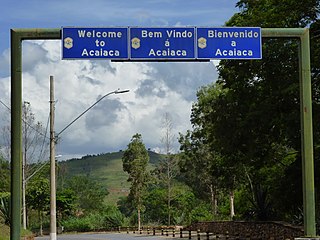Talian, or Brazilian Venetian, is a Venetian dialect spoken primarily in the Serra Gaúcha region in the northeast of the state of Rio Grande do Sul in Brazil. It is also spoken in other parts of Rio Grande do Sul, as well as in parts of Espírito Santo and of Santa Catarina.

The Riograndense Republic, often called the Piratini Republic, was a de facto state that seceded from the Empire of Brazil and roughly coincided with the present state of Rio Grande do Sul. It was proclaimed on 11 September 1836 by general Antônio de Sousa Neto as a direct consequence of the victory obtained by gaúcho oligarchic forces at the Battle of Seival (1836) during the Ragamuffin War (1835–1845). It had a constitution adopted in 1843 and was recognised only by the United Kingdom, France, and Uruguay.

Portuguese is the official and national language of Brazil being widely spoken by most of the population. Brazil is the most populous Portuguese-speaking country in the world, with its lands comprising the majority of Portugal's former colonial holdings in the Americas.

Áurea is a municipality in the state of Rio Grande do Sul, Brazil. As of 2020, the estimated population was 3,535.
Erval Seco is a municipality in the state of Rio Grande do Sul, Brazil. It was raised to municipality status in 1963, the area being taken out of the municipalities of Seberi, Palmeira das Missões, and Tenente Portela. As of 2020, the estimated population was 6,802.

Machadinho is a municipality in the state of Rio Grande do Sul, Brazil. It was raised to municipality status in 1959, the area being taken out of the municipality of Lagoa Vermelha. As of 2020, the estimated population was 5,427.

Pareci Novo is a municipality in the state of Rio Grande do Sul, Brazil. It was raised to municipality status in 1992, the area being taken out of the municipality of Montenegro.

São Vendelino is a municipality in the state of Rio Grande do Sul, Brazil. It was raised to municipality status in 1988, the area being taken out of the municipality of Bom Princípio.

Serras de Sudeste is a dissected plateau, also named Planalto Dissecado de Sudeste or Escudo Sul-Rio-Grandense, located in the southeastern portion of Rio Grande do Sul state in southernmost Brazil, near Uruguay.

Bom Jesus is a neighbourhood (bairro) in the city of Porto Alegre, the state capital of Rio Grande do Sul, in Brazil, with a population of 11202, and covering an area of 2.6 million km². It was created by Law 5799 from December 15, 1986, but had its limits modified by Law 6594 from January 31, 1990.

The governor of Rio Grande do Sul is the head of government of the state's executive branch, assisted by his secretaries, whom he freely chooses. Elected by absolute majority in universal suffrage, together with the vice-governor, his term lasts four years; since 1997, reelection has been possible, and although all have sought it, none has succeeded. The current governor is Eduardo Leite, since January 1, 2023.

The Piratini Palace is the current seat of the Executive Branch of the Brazilian state of Rio Grande do Sul. It is located at Marechal Deodoro Square, also known as the Mother Church Square, in Porto Alegre's historic center. The Piratini Palace has been the official residence of thirty-eight governors.

The Casa da Junta, also known as the Old Legislative Assembly, is a historic building in the Brazilian city of Porto Alegre, the capital of the state of Rio Grande do Sul, located at 1029 Duque de Caxias Street, at the historic center. It is likely the only building in Porto Alegre dating back to the 18th century.

A Xis, also known as a Xis gaúcho, is a sandwich from the Brazilian state of Rio Grande do Sul that was inspired by the American cheeseburger. The sandwich consists of meat, cheese, lettuce, tomato, peas, corn, and mayonnaise served on a bread bun larger than a typical hamburger bun. The meat used can vary with some common choices being a beef patty, chicken hearts, fish fillets, chicken breast, calabresa sausage, bacon, or fried eggs. Vegetarian variants that use meat alternatives exist. The sandwich is pressed on a grill and served hot.

The flag of Rio Grande do Sul is the official flag of the Brazilian state of Rio Grande do Sul.

The flag of Paraíba is the official flag of the Brazilian state of Paraíba. The initial version of the modern day flag was first adopted on 25 September 1930 by State law no. 704.



























